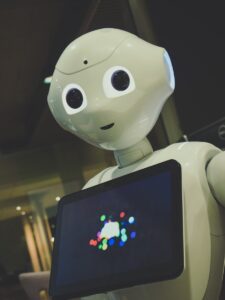Where is diabetic technology?
OK, I’m a Star Trek fan. Even back in the original series computers have been talking to the crew. We didn’t call it Artificial Intelligence (AI), but it was clear the computer was pretty advanced. And as new seasons came and went the computer became more personable. After spending 35 years in the computer world I shouldn’t be surprised to see computers stepping in to do tasks in our world. However, it is a surprise. I don’t know if I would trust a computer get or not. What are your thoughts? Can AI provide diabetes-supporting care?
Anyhow, as the late Paul Harvey would say, “Now the rest of the story.”
Monitoring chronic disease
Chronic diseases, such as heart disease, stroke, cancer, and diabetes, have become a large cost to healthcare systems around the world over the past few decades. In fact, chronic diseases are a big part of the top ten causes of death in high-income countries. The good news is that many chronic diseases are preventable through lifestyle changes such as eating healthy, being active, and not smoking.
A very comprehensive approach to the management of chronic disease needs to cover all segments of these complex diseases. Efforts to manage conditions are required, but other resources are required to prevent disease problems. A multidisciplinary team approach is often necessary in order to provide patients with the best care possible. This team may include primary care physicians, specialists, nurses, social workers, and others who can help assess a patient’s needs and create a plan of care.
The role of data in disease management strategies is more important than ever before. Data is being used to better healthcare programs and it is a great source of evaluation and enhancements in the healthcare industry.
Data visualization has proved to be an effective way to create insights for decision-makers. One of the leading chronic diseases is diabetes.
With the global burden of disease expected to increase exponentially in the coming years, healthcare leaders are looking for insightful, evidence-based approaches to address this issue. They hope to find ways to prevent or at least slow down the progression of diseases so that patients can enjoy a better quality of life for longer.
Where technology is today
Continuous Glucose Monitoring Devices are a new field of devices powered by artificial intelligence. Automatic and real-time data on the rate of change and concentrations of blood glucose can be found in these devices. The data is used to improve predictions of hypoglycemic events and to deliver more personalized information to the user about their current state of glycemia.
Specifically, these devices use the vast amount of patient data available to provide personalized recommendations for treatment administration, greatly minimizing the risks associated with exogenous insulin administration. By tailoring administration specifically to the individual patient, these devices hope to achieve better clinical outcomes while decreasing the chance of dangerous side effects.
The artificial pancreas pilot program that applies closed-loop technology to monitor blood sugar continually and automatically adjust the amount of diabetes medicine will be offered to 1,000 patients in 2021. This program has the potential to revolutionize the management of diabetes and improve the quality of life for those who suffer from this chronic condition.
The use of artificial intelligence allows us to identify patients who are at high risk for diseases. This helps us provide them with the necessary care and treatment before the disease progresses. Artificial intelligence is a valuable tool in healthcare that can help improve patient outcomes.
In a study, a trained machine-learning model using features collected from over one million patients across multiple data sources. This model was able to predict with high accuracy the risks of cardiovascular and hyperglycemic events in people with diabetes, over the course of three years. Our results suggest that machine-learning models can be used to accurately predict risks for various diseases, making them a valuable tool for preventative healthcare.
Earlier diagnoses
This research provides valuable insights that could improve clinical outcomes for patients with diabetes. By promoting the delivery of early and personalized care, patients with diabetes can receive the treatment they need as soon as possible. This can help to improve their overall health and quality of life.
The use of artificial intelligence is being applied to detect patterns in behaviors that result in high or low blood sugar levels in people with diabetes. A large amount of data has previously been unanalyzed by continuous GLP-1, which is commonly used by people with Diabetes.
However, recent studies have shown that by using machine learning algorithms on this data, it is possible to accurately predict glucose levels up to two hours in advance. This information could be used to develop new Insulin treatments or changes in lifestyle that could help people with Diabetes better manage their condition.
In order to more accurately detect low blood sugar levels, scientists have devised an artificial intelligence system that uses data from the Continuous Glucose Monitoring (CGM) device and a non-invasive sensor. This system has the potential to provide a more reliable way of detecting low blood sugar levels, as well as being less invasive than traditional methods.
Your CGM will need to be calibrated often to make sure it is providing accurate readings. The amount of fluid in your body has to be measured with a CGM (continuous glucose monitoring) device. Many gadgets are small and use tiny sensors to capture information about your blood sugar levels. In certain cases, the sensor is placed under your skin on the belly or in the back of your arm.
The sensor on your belt will transmit information about your heart rate and other vital signs to a wireless monitor that you will clip onto your belt. The monitor will then display the information on a screen so that you can see it.
Dreaming of the future
Technology continues to make advances in the ability to provide diagnostic data. The biggest challenge will be providing the latest technology to those who need it. Diabetes is a worldwide problem. Once again the question is, “Can AI provide supporting care?”
Please join our Facebook group, Dancing with Diabetes, and the other articles on our blog pages.
Source: HOSPITALS MAGAZINE, DiabetesTimes, MD+DI










